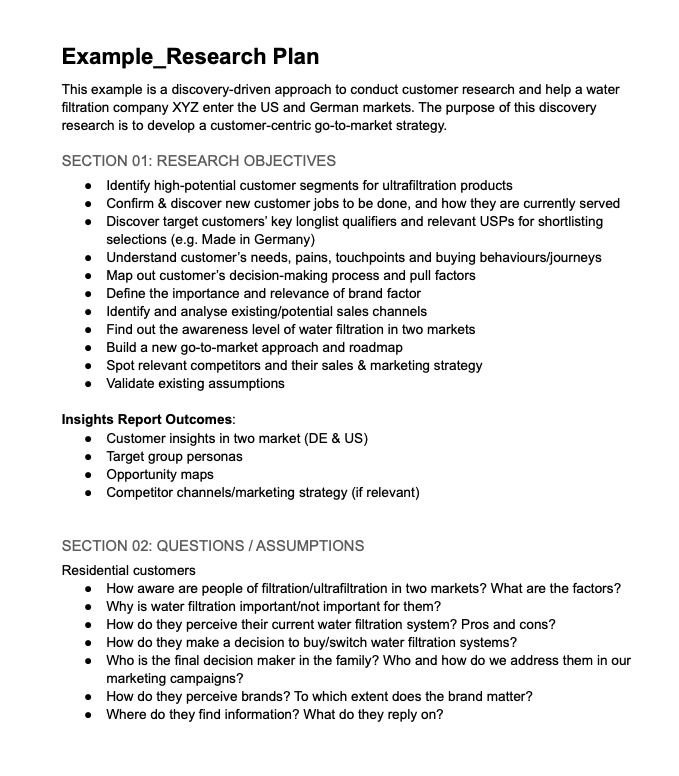Previous
¶ Research Plan
¶ What it is
From the Orientation, you should have collected enough information to understand the problem you are trying to solve, the things you know about the problem and the things you don’t know.
As you enter the next phase, you set up a research plan that should help close your knowledge gaps. A common research structure includes:
- Research Objectives (knowledge gaps and outcomes you want to get out of this primary research)
- Questions / Assumptions (what you want to learn or the assumptions you want to validate in this research)
- Methodology
- Qualitative Approach to data collection
- Quantitative Approach to data collection
¶ Why it is useful
The Research Plan is a north star for properly setting up the customer research and a foundation for scripting the customer interview.
¶ When to use it
Before we start the primary/customer research, a Research Plan has to be set out to have clarity and focus for the team.

¶ How is it done
- Review your discovery goal statement. Identify your knowledge gaps (what do we know about customers and what do we want to learn?).
- Develop research questions/detailed research objectives that help close your knowledge gaps. These research questions will be helpful to keep in mind when you conduct your research - does the new information you are collecting answer your research questions?
- Decide which research questions are essential to be answered. Then, review and critically question whether closing your knowledge gaps would help you better understand the problem to be solved.
- Identify the people who could help you answer your questions. Think about whom to ask to get clarification. Which stakeholders can shed light on the research gaps? Write down the departments, customer groups, or people you want to learn from next to the research questions.
- Set up a sample strategy (who/profiles and how many interviewees involved) and recruitment plan (both will be discussed in the following chapter)
- Identify the proper research tools which could help you answer your questions. A comprehensive list of tools is provided in the Research chapter, from which you can select the proper methods depending on your research questions and available resources.
¶ Do's & Don't
Do's
- You and your team decide which tools you see as most suitable for your project. In general, Shadowing, Service Safaris, and Diary Studies help understand the Whats and Hows of your research (e.g., how is an inspection journey conducted). Meanwhile, Qualitative Interviews and Focus Groups allow you to capture the Whys (e.g., why do you need to get approval to conduct a spot check)
- If the research question doesn’t help you to understand the problem better, decide whether there is still value to close this gap (and whether it should be included in the Problem Statement) or whether you will leave the question aside.
Don't
- Don’t start the research without a research plan; a well-defined research plan can directly determine the quality and success of the research outcomes.
¶ Tools needed
- Whiteboard (virtual)
- Word